Intel SSD 520 Review: Cherryville Brings Reliability to SandForce
by Anand Lal Shimpi on February 6, 2012 11:00 AM ESTAnandTech Storage Bench 2011
Last year we introduced our AnandTech Storage Bench, a suite of benchmarks that took traces of real OS/application usage and played them back in a repeatable manner. I assembled the traces myself out of frustration with the majority of what we have today in terms of SSD benchmarks.
Although the AnandTech Storage Bench tests did a good job of characterizing SSD performance, they weren't stressful enough. All of the tests performed less than 10GB of reads/writes and typically involved only 4GB of writes specifically. That's not even enough exceed the spare area on most SSDs. Most canned SSD benchmarks don't even come close to writing a single gigabyte of data, but that doesn't mean that simply writing 4GB is acceptable.
Originally I kept the benchmarks short enough that they wouldn't be a burden to run (~30 minutes) but long enough that they were representative of what a power user might do with their system.
Not too long ago I tweeted that I had created what I referred to as the Mother of All SSD Benchmarks (MOASB). Rather than only writing 4GB of data to the drive, this benchmark writes 106.32GB. It's the load you'd put on a drive after nearly two weeks of constant usage. And it takes a *long* time to run.
1) The MOASB, officially called AnandTech Storage Bench 2011 - Heavy Workload, mainly focuses on the times when your I/O activity is the highest. There is a lot of downloading and application installing that happens during the course of this test. My thinking was that it's during application installs, file copies, downloading and multitasking with all of this that you can really notice performance differences between drives.
2) I tried to cover as many bases as possible with the software I incorporated into this test. There's a lot of photo editing in Photoshop, HTML editing in Dreamweaver, web browsing, game playing/level loading (Starcraft II & WoW are both a part of the test) as well as general use stuff (application installing, virus scanning). I included a large amount of email downloading, document creation and editing as well. To top it all off I even use Visual Studio 2008 to build Chromium during the test.
The test has 2,168,893 read operations and 1,783,447 write operations. The IO breakdown is as follows:
| AnandTech Storage Bench 2011 - Heavy Workload IO Breakdown | ||||
| IO Size | % of Total | |||
| 4KB | 28% | |||
| 16KB | 10% | |||
| 32KB | 10% | |||
| 64KB | 4% | |||
Only 42% of all operations are sequential, the rest range from pseudo to fully random (with most falling in the pseudo-random category). Average queue depth is 4.625 IOs, with 59% of operations taking place in an IO queue of 1.
Many of you have asked for a better way to really characterize performance. Simply looking at IOPS doesn't really say much. As a result I'm going to be presenting Storage Bench 2011 data in a slightly different way. We'll have performance represented as Average MB/s, with higher numbers being better. At the same time I'll be reporting how long the SSD was busy while running this test. These disk busy graphs will show you exactly how much time was shaved off by using a faster drive vs. a slower one during the course of this test. Finally, I will also break out performance into reads, writes and combined. The reason I do this is to help balance out the fact that this test is unusually write intensive, which can often hide the benefits of a drive with good read performance.
There's also a new light workload for 2011. This is a far more reasonable, typical every day use case benchmark. Lots of web browsing, photo editing (but with a greater focus on photo consumption), video playback as well as some application installs and gaming. This test isn't nearly as write intensive as the MOASB but it's still multiple times more write intensive than what we were running last year.
As always I don't believe that these two benchmarks alone are enough to characterize the performance of a drive, but hopefully along with the rest of our tests they will help provide a better idea.
The testbed for Storage Bench 2011 has changed as well. We're now using a Sandy Bridge platform with full 6Gbps support for these tests.
AnandTech Storage Bench 2011 - Heavy Workload
We'll start out by looking at average data rate throughout our new heavy workload test:
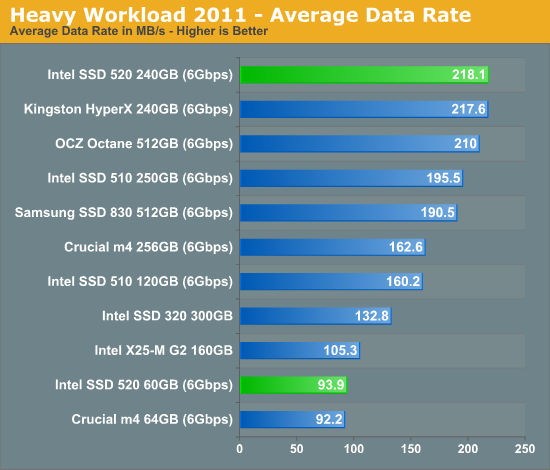
SandForce has always done well in our Heavy Workload test, and the 520 is no different. For heavy multitasking workloads, the 520 is the fastest SSD money can buy. Note that its only hindrance is incompressible write speed, which we do get a hint of in our breakdown of read/write performance below.

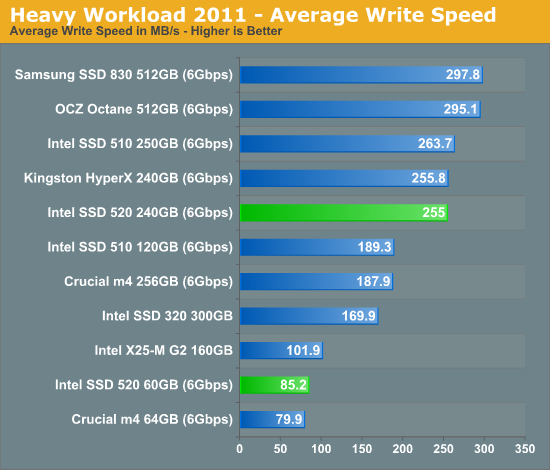
The next three charts just represent the same data, but in a different manner. Instead of looking at average data rate, we're looking at how long the disk was busy for during this entire test. Note that disk busy time excludes any and all idles, this is just how long the SSD was busy doing something:
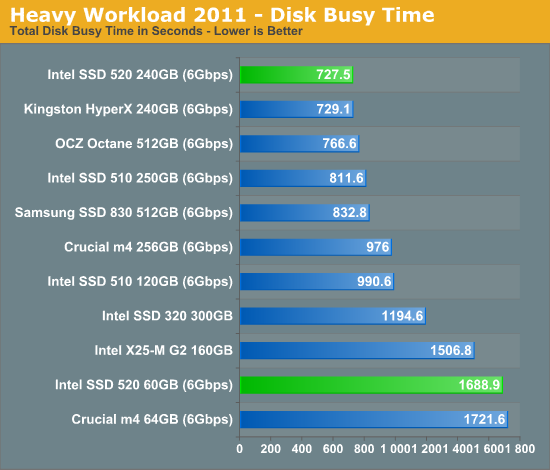
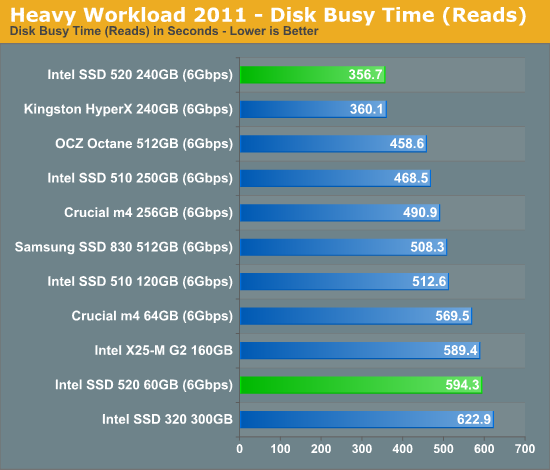
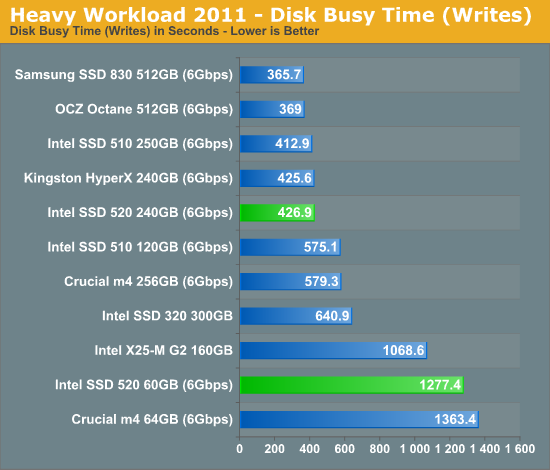










138 Comments
View All Comments
Beenthere - Wednesday, February 8, 2012 - link
Unfortunately Intel just like OCZ, Corsair and most all the rest of the SSD purveyors have adopted the Asus Biz model where you ship it today and hope you can fix it tomorrow when people find it's got lots of defects.It's totally unscrupulous to ship products with defects that have not been corrected due to a proper validation procedure not being implemented because the mfg. was more interested in rushing the product to market for quick profits or they are simply incompetent.
If you bought a new car and the brakes didn't function you'd have a Helleva lawsuit. If the car's trans only worked on Wednesdays and Fridays, you'll have a Helleva lawsuit. If the car maker only responded to the problems by replacing the defective product with another defective product - yup, you'd have a Helleva lawsuit.
This is how a lot of SSD companies are responding the defects in consumer grade SSDs.
NitroWare - Thursday, February 9, 2012 - link
I understand what your saying but ASUS is a company who do no skimp on overall validation of their products. This can be objectively proven by comparing their BIOS changelogs and QVL lists against a tier 2 manufacturer.Enthusiast products are touch and go especially when high speeds or aggressive compatibility is involved. You can not have it both ways wether its a SSD, Mobo, VGA or even a car
There are 'stable' products and there are 'aggressive' products (esp mobos and vga)
The stable products, Intel Desktop Boards, Supermicro server/workstation boards, DELL/HP Prebuilts and some basic generic motherboards are BORING to part of the target market who are being targeted by cheap and fast SSDs.
Do dell even validate many different SSD controller on their desktop and portables?
There are firms who have SSD in Mission Critical apps. Either Team Lotus or Red Bull F1 I forget who switched all their pitcrew laptops to SSD due to vibration from the F1 engines.
Can you imagine what would happen if an engineer experiencing a BSOD such a frantic scenario ?
The target market want the bleeding edge and many vendors are forced to comply by playing the numbers game or including technical features on their products which have no benefit (eg extra power sockets) except as a marketing bulletpoint targeted to enthusiasts and matching their competition.
Many would be surprised how many features on components such as motherboards or power supplies are stuck on simply due to customer (OEM) requests or technical marketing/competitive demands.
There are parts of the enthusiast community, especially extreme and sub zero overclockers who don't care about 'stability' or who do not understand what the true meaning of this is. Their definition is stability is how much LN2 they can pour by balancing one hand with another hand on their mouse in vain effort to get their overclock stable.
Manufs of cheaper devices have never really cared about support and many have a small handful of design engineers who are already overworked. This has not changed in twenty years of PC add on devices.
It is a shame that some 'brand names' currently have issues really, a damm shame.
vol7ron - Tuesday, February 7, 2012 - link
One of Intel's biggest advantages was the spread spectrum of their wear-leveling controller. I may have missed it, but I didn't see any mention of it in the article.It would be nice if they could have combined the SF-2281 with their own controller to give a fast, controller that was spread evenly across the NAND, to further increase its shelf-life. Maybe that would be too costly, or maybe it wasn't needed, but I'm interested to hear what they have to say.
vol7ron
Sufo - Wednesday, February 8, 2012 - link
So, will the 720 be based on SF-2000? How far away is that?I'm soon to be building an enterprise server... are these Intel drives (5xx or 7xx) really up to enterprise load? Unlike many people, being able to pick something like the 710/720 would be a huge cost _saving_ - it seems to me that approved drives such as the HP ones cost 10x more than even these Intel drives.
On a side note, since Apple's acquisition of Anobit, is it safe to say the Genesis 2 is on hold?
Beenthere - Wednesday, February 8, 2012 - link
The story title is really inappropriate considering there is no proof that the 520 is any more reliable than other SSDs. There are even reports already of BSOD on the 520 drives at Intel's customer support forums.Wolfpup - Wednesday, February 8, 2012 - link
No question, BUT I'd still pick my Intel 320 over the 520. I still trust Intel's controller more, and the 320 is the only drive I know of that has built in hardware encryption. Completely awesome! I'm sure there must be other drives that do too, but that alone would have me picking the 320, and then when you consider I trust it more anyway, and it's a bit cheaper...Wish the 600GB 320 wasn't over $1000 though :-D Oh well, my 300GB one is okay, and my Seagate Momentus XTs are great too.
Beenthere - Wednesday, February 8, 2012 - link
Already reports of 520 BSOD at Intel support... :(Galvin - Friday, February 10, 2012 - link
I could get a BSOD and report in intel forums too. All I have to do is disable AHCI drivers in windows and reboot. Get a BSOD. I think the issue is not the drive but the user not setting their bios up correctly or windows correctly or both.Galvin - Friday, February 10, 2012 - link
Just wanted to update if you read that post. He fixed the problem. It had nothing to do with the drive. People want to hate intel just cause they're intel.mbryans - Thursday, February 9, 2012 - link
Intel SSD 520 Series 480 GB: random 4 KB writes up to (only) 42,000 IOPS? While for 240 GB could reach 60,000 IOPS. The greater capacity should be faster.